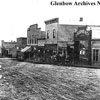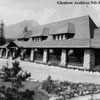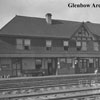Beginnings to the End of World War II

Before the Second World War, West Central Alberta’s economy was based largely on the coal industry, forestry, and tourism.
Hinton was one of the new boom towns created by the construction of the Grand Trunk Pacific line, from 1908 to 1911. The town was named for the general superintendent of the Grand Trunk Pacific.
Jasper, situated on the popular Athabasca Pass during the early days of the fur trade, had started as a fur trading post called Jasper House. But with the coming of the railway, Jasper National Park was established by the Government of Canada in 1907. Then the new Jasper townsite, known initially as Fitzhugh, began to take shape in 1911, with the building of the railway station. Although it was the gateway to the new national park, Jasper remained a small settlement with very few tourist facilities up until the 1920s.

The settlement of Edson began in 1910 when the Grand Trunk Railway arrived. Initially, the line was to be built connecting the hamlet of Wolf Creek; however, in the ensuing real estate boom, speculators bought up all the real estate making the cost of building a station in the hamlet prohibitive. Thus, Edson was chosen and a real estate boom commenced. In August of 1910, Edson had a paltry population of 15, but by March of 1912, the population had skyrocketed to 1233. The main street on which the station was built evolved, gaining a two-storey hotel in 1910, and the next year, a national bank, a restaurant, a store and post office as well as an immigration hall all dotted main street’s landscape. On September 21, 1911, Edson was officially incorporated as a town, and four schools that year were built to keep up with rising enrollment. By 1912, the town council had planned an eight-room brick school to be built at a cost of $60,000. And by 1913, Edson had its own hospital. The Edson Townsite Company promoted town lot sales to investors in large Canadian and American cities; this company, and all the other land agents in town, were tremendously busy and raking in profits as they sold land at more than double the price they paid. Although the railway was the main cause of this growth, Edson was also an important stopover for travelers heading from Edmonton to Grande Prairie via the Edson to Grande Prairie Trail. In addition to having several logging camps and lumber mills, during the height of the boom, Edson became home to the Marlboro Cement Company plant. In 1914, oil speculation was rife in the area, giving birth to the Edson Oil Syndicate.

However, by the start of the First World War, Edson’s boom had climaxed due to overspeculation as the high real estate prices became untenable. During the First World War, Edson suffered an economic downtown. This was heightened by the completion, in 1916, of the Edmonton, Dunvegan & British Columbia Railway, which created a route to Grande Prairie that bypassed Edson. The town suffered a drastic loss in population that year, going from about 1200 to merely 500. By 1917, Edson’s fate rested upon a decision about whether to close the Canadian Northern Railway line or the Grand Trunk Pacific line upon which Edson depended. Luckily the Grand Trunk Pacific Line was saved. Other settlements that had the misfortune of being on the Canadian Northern Railway, such as the boom town of Tollerton, did not survive.
Edson spent the next few decades of its life as a small, stable settlement surviving on a modest lumber industry, some small scale farming and fur trade, as well as a burgeoning coal industry. A branch line was built through the Brazeau coal fields along the Luscar, Cadomin, and Mountain Park camps to Edson, making Edson an important shipping point for the coal industry.

During the 1920s, new life entered the settlements along the Grand Trunk Pacific. Hinton became a major coal mining towns, with large scale operations from1924 until 1941, the year trains switched their fuel to diesel and no longer required coal. In the 1920s, a highway was being built from Edmonton to Jasper, increasing traffic to the tourist town. The railway continued to be Jasper’s most important source of income and development; Jasper’s first great tourist attraction was the Jasper Park Lodge, built by the Canadian National Railway in 1922; two years later, the CNR built an internationally renowned golf course, and Jasper was getting over 10,000 visitors a year by this time.

The local railway yards also remained as the critical industry for Edson—Edson benefited from increased shipments of wheat and coal to and from the town. While the coal industry expanded, so did farming in the area as a drought in southern Alberta pushed farmers north. The agricultural industry remained relatively small, however, because of the labour intensive task of clearing the land of trees. By the beginning of the next decade, Edson’s population had risen slowly to 1547. Its economy was beginning to prosper again. A one storey addition was made to the large red brick school, and in 1931, St. John’s Hospital was built at a cost of $90,000. A highway between Edmonton and Jasper was gradually taking place, slowly carved through the muskeg lands around Edson. Five miles from Edson at Moose Creek, clay deposits were discovered, leading Claynett Ltd. to establish a plant for the milling, grinding and processing of commercial clays in 1933. Mineral exploration in general had increased in the area demonstrating vast economical potential. But the Great Depression loomed around the corner. Early in the decade, the stock market slump wreaked havoc on the lumber industry; lumber could not be sold at a decent price, so mills and logging camps were shutting down. By mid-decade, all industries felt the pinch. Unemployment rates were high, and most families were on welfare.

During the war, West Central Alberta did not see considerable growth. The coal industry was waning because the railways switched from coal to diesel fuel. Hinton, a coal mining town, was suffering, but high activity in oil exploration and drilling promised a reversal in fortunes. In Edson, the war did alleviate the unemployment situation, but there was little growth. There were a few new residents, mainly from the Prisoner of War Camp at Granada. After the POWs were sent home following the war, some of the prisoners opted to return to the area. Returning soldiers also brought war brides with them, bumping up the population of the small town. After the war, Edson would see new growth with the expansion of the forestry industry and the growth of a new industry, oil.
References
Ahlf, Marguerite. Edson – 75 Years: A History of the Town, 1986.
Bargery, Mary. Picture Hinton, Entrance, Brule and Cadomin. Hinton Municipal Library, 1999.
C. J. Taylor. The Railway and Jasper National Park. Western Canada Service Centre, Parks Canada, June 2004.
Industrial Development Branch, Department of Industry & Development. Survey of Hinton. Government of the Province of Alberta, 1963.



